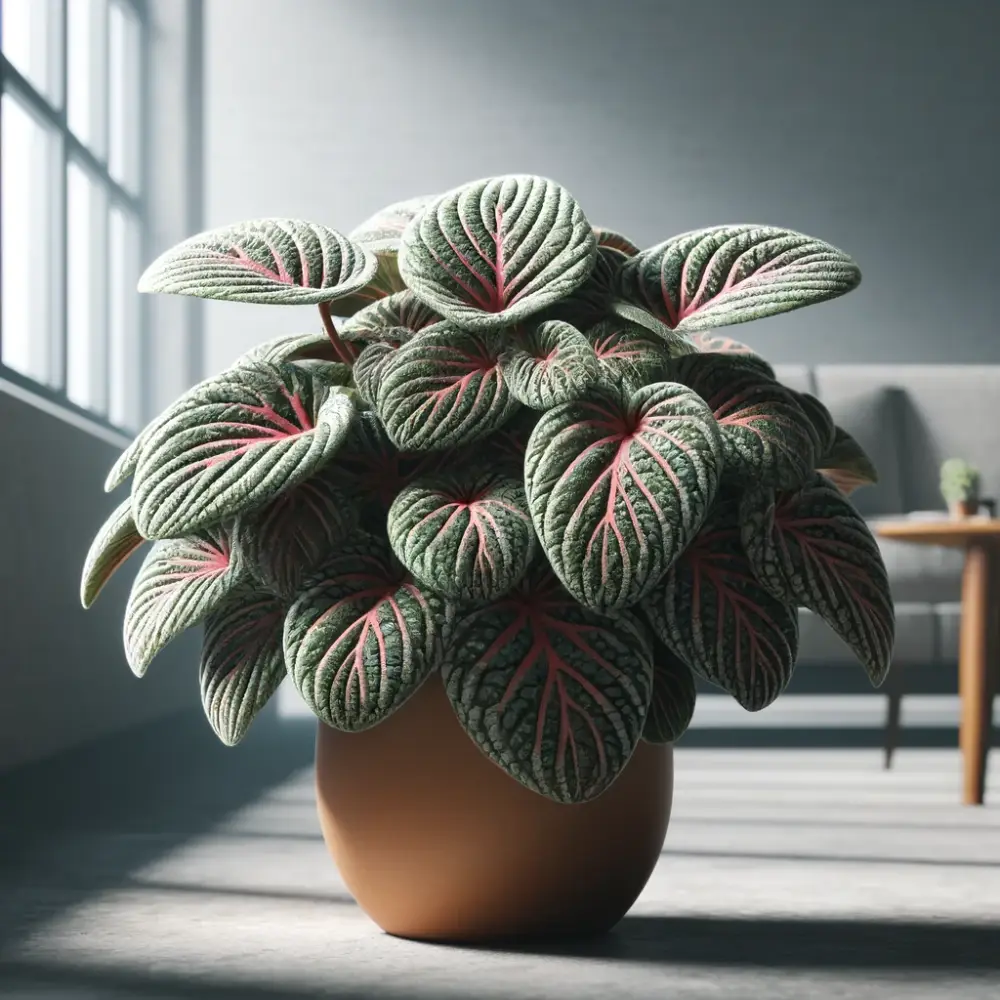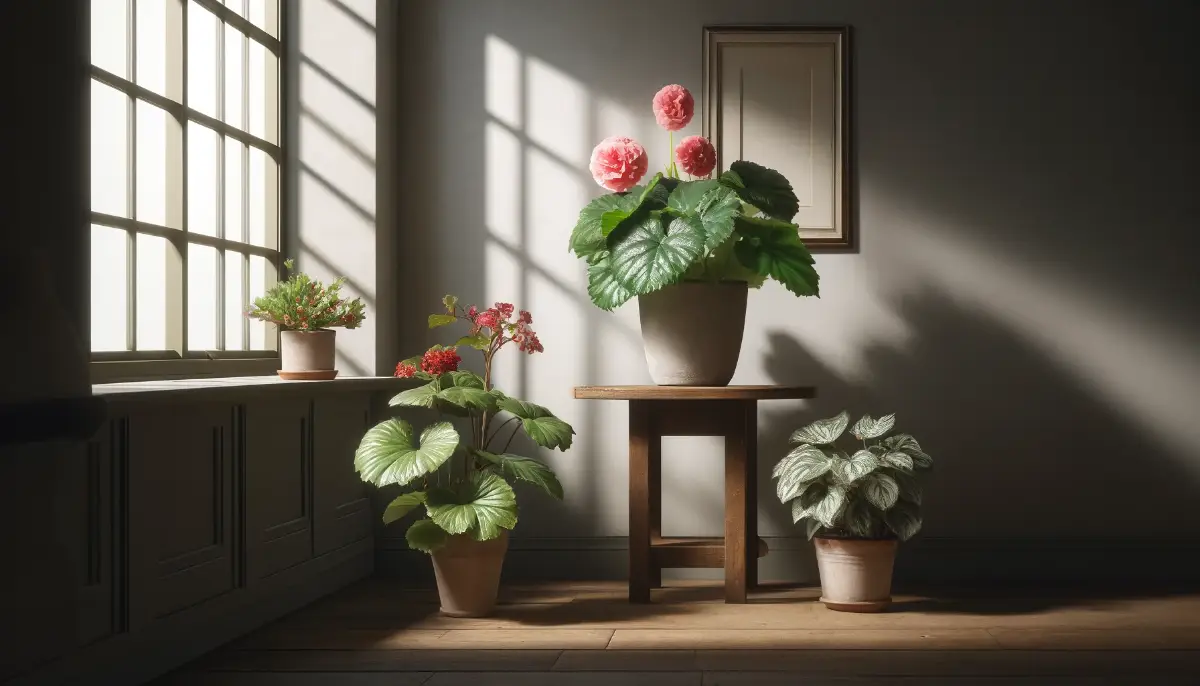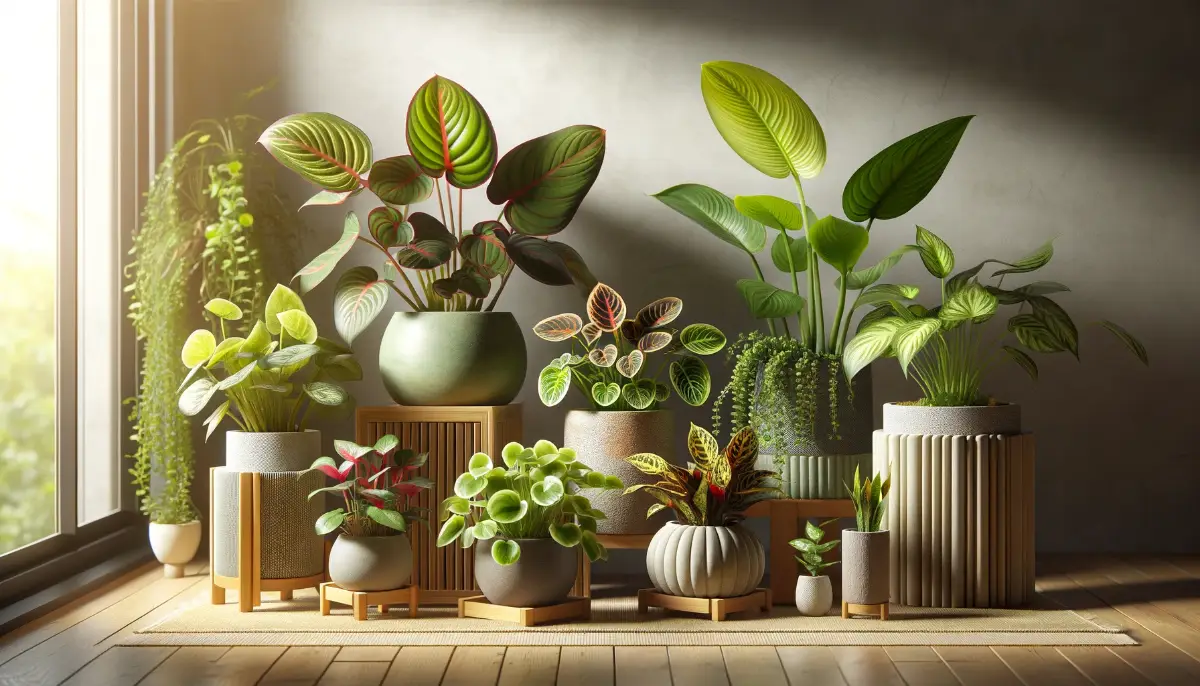Fittonia, commonly known as the Nerve Plant, is a striking addition to any indoor garden due to its richly veined, colorful leaves.
This small, low-growing plant is native to the tropical rainforests of South America, particularly Peru. Its lush leaves are typically adorned with contrasting veins, making it a popular choice for adding a splash of color and texture to indoor spaces.
Caring for a Fittonia at home is rewarding but requires attention to detail. The plant thrives under specific conditions of light, humidity, and temperature, which mimic its natural rainforest habitat. Given its sensitivity to environmental changes, understanding and replicating these conditions is crucial for the plant’s health and vibrancy.
Fittonia’s Characteristics: Characteristics and Natural Habitat Preferences
Fittonia, also known as the Nerve Plant, is admired for its strikingly decorative foliage, which features intricate vein patterns that stand out against the rich green leaves. To provide the best care, it’s essential to understand its unique characteristics and natural habitat preferences. Here’s a detailed breakdown:
Physical Description
- Leaves: Fittonia’s leaves are its most distinctive feature. They are small and oval-shaped with pronounced, colorful veins. The vein colors can vary widely, from white and pink to deep red, depending on the variety.
- Growth Habit: The plant typically grows as a spreading evergreen with a low, creeping growth pattern. It rarely exceeds a few inches in height but can spread up to 18 inches wide, making it ideal as a ground cover in container gardens.
Varieties of Fittonia
- Fittonia comes in several varieties, each with its unique vein coloration and leaf size. Some common varieties include:
- Fittonia ‘Red Anne’: Known for its bright red veins.
- Fittonia ‘White Anne’: Features stark white veins.
- Fittonia ‘Mini Super Red’: Offers a more compact form with vibrant red veins.
- Each variety retains the same care requirements but can offer different aesthetic appeals depending on the vein colors and leaf sizes.
Native Habitat and Growth Habits
- Origin: Native to the tropical rainforests of South America, Fittonia thrives in warm, humid environments under the canopy of larger trees.
- Understory Plant: As an understory plant, Fittonia is accustomed to low light conditions and high humidity, which are critical factors to replicate in a home environment for the plant to thrive.
- Soil and Moisture: In its natural habitat, Fittonia grows in rich, moist, well-drained soils that are high in organic matter.
Watering and Feeding Fittonia (Organic Methods)
Proper watering and feeding are crucial for maintaining a healthy Fittonia plant. Given its native tropical environment, the plant requires consistent moisture and nutrient-rich conditions to thrive. Here’s a guide to help you water and feed your Fittonia using organic methods:
Watering Fittonia
Frequency and Amount
- Fittonia prefers evenly moist soil but not waterlogged. During the growing season (spring and summer), water the plant thoroughly when the top inch of the soil feels dry to the touch.
- Reduce watering in the cooler months (fall and winter) to prevent root rot, allowing the topsoil to dry out slightly more between waterings.
Techniques
- Bottom Watering: This technique involves placing the pot in a tray of water and allowing the soil to absorb moisture from the bottom up. This method helps prevent the leaves from getting wet, which can lead to fungal infections.
- Misting: Fittonia benefits from high humidity. Regular misting helps mimic its native rainforest habitat, especially in dry indoor environments.
Water Quality
- Use room-temperature water to avoid shocking the plant’s roots. If your tap water is hard or contains chemicals, consider using filtered or distilled water to prevent leaf tip burn.
Organic Feeding
Fertilizer Selection
- Choose an organic liquid fertilizer that is balanced (e.g., NPK 10-10-10) or slightly higher in nitrogen to promote lush leaf growth. Make sure it’s suitable for indoor plants and diluted to half the strength recommended on the package.
Feeding Schedule
- Feed your Fittonia every 4-6 weeks during the growing season. Avoid fertilizing in the winter when the plant’s growth naturally slows down.
- Over-fertilizing can lead to nutrient burn, so it’s crucial to follow the recommended dilution and frequency.
Organic Alternatives
- Compost Tea: A gentle, effective organic option is to use compost tea. You can make it by steeping compost in water to create a nutrient-rich solution, which can then be diluted and used to water the Fittonia.
- Worm Castings: Incorporating worm castings into the soil mix or as a top dressing provides slow-releasing nutrients and enhances soil health.
Pruning and Maintenance of Fittonia (Nerve Plant)
Regular pruning and maintenance are essential for keeping your Fittonia healthy and attractive. These practices help control the plant’s shape, encourage fuller growth, and prevent disease. Here’s a detailed guide to effectively pruning and maintaining your Fittonia:
Pruning Fittonia
When to Prune
- Prune during the growing season (spring and summer) when the plant is most resilient and can recover quickly from trimming.
- Avoid heavy pruning in the winter months as the plant’s growth slows down.
How to Prune
- Remove Dead or Yellow Leaves: Regularly check for and remove any dead or yellowing leaves to keep the plant looking its best and to prevent potential spread of disease.
- Trim Back Overgrowth: Use clean, sharp scissors or pruning shears to cut back overgrown stems. This encourages the plant to become bushier, as new growth typically occurs near the cut areas.
- Shape the Plant: If you prefer a specific shape or size, gently shape the plant by evenly pruning its stems. This is particularly useful if you are growing Fittonia in a terrarium or as part of a mixed container.
Cleaning the Leaves
- Dust Removal: Fittonia’s leaves can accumulate dust, which can hinder photosynthesis and growth. Gently wipe the leaves with a damp cloth or use a soft brush to remove dust.
- Avoid Chemical Leaf Shine Products: These can clog the pores of the leaves and should be avoided. Instead, a natural shine can be achieved by simply keeping the leaves clean and healthy.
Regular Maintenance
Pest Control
Regularly inspect your Fittonia for signs of pests such as aphids, spider mites, and mealybugs. Early detection is key to effective control.
If pests are found, use organic pest control methods like neem oil or insecticidal soap. Apply these treatments according to their instructions, typically in the evening or when the plant is not in direct sunlight.
Disease Prevention
Ensure good air circulation around the plant to prevent the buildup of excess humidity, which can lead to fungal infections.
Avoid overhead watering and keep the foliage dry during watering to minimize the risk of leaf spot diseases.
Soil and Pot Check
Repotting: Fittonia should be repotted every 2-3 years or when it outgrows its pot. Use a fresh potting mix suitable for tropical plants to refresh the nutrients available to your plant.
Drainage: Ensure the pot has good drainage to prevent water from pooling at the bottom.
Propagation Techniques for Fittonia (Nerve Plant)
Propagating Fittonia is a straightforward process that can be rewarding, as it allows you to expand your plant collection or share with friends. Fittonia can be propagated through stem cuttings or leaf cuttings. Here’s a step-by-step guide for each method:
Stem Cuttings
- Select a Healthy Stem
Choose a healthy, robust stem with at least 2-3 leaf nodes. Leaf nodes are small bumps on the stem from which leaves grow.
- Cut the Stem
Using a clean, sharp pair of scissors or pruning shears, cut just below a node. The cutting should be about 3-4 inches long.
- Prepare the Cutting
Remove the leaves from the lower half of the cutting to expose the nodes. This prevents the leaves from rotting when submerged in water or soil and focuses the plant’s energy on root development.
- Rooting Medium
Water Method: Place the stem cutting in a glass of water, ensuring that the nodes are submerged. Change the water every few days to keep it fresh.
Soil Method: Dip the cut end into rooting hormone powder or gel (optional but can enhance rooting success). Plant the cutting in moist potting soil, ensuring that the nodes are buried.
- Environment
Place the cutting in a warm, well-lit area but out of direct sunlight. High humidity is beneficial, so consider covering the cutting with a plastic bag to create a mini greenhouse effect, ensuring to open it occasionally to prevent mold.
- Root Development
Roots should begin to appear within 2-4 weeks. Once the roots are several inches long (in water) or the plant shows new growth (in soil), the cutting is ready to be transplanted into a regular pot.
Leaf Cuttings (less common but possible)
- Leaf Selection and Cutting
Choose a healthy, full leaf and cut it off with a small portion of the stem attached.
- Rooting Medium
Place the leaf on moist potting soil, slightly burying the stem end into the soil.
- Care and Environment
As with stem cuttings, keep the soil moist and cover with a plastic bag to maintain humidity. Place in a warm, bright area out of direct sunlight.
- Root Development
Roots and new shoots will develop from the buried stem end. This can take longer than stem cuttings, so patience is necessary.
Fittonia propagation is most successful when environmental conditions are closely monitored and maintained. Both methods can yield new plants, allowing you to expand your collection and share with others.
Design and Aesthetic Uses of Fittonia in Home Decor
Fittonia, with its vividly veined and colorful foliage, is an excellent choice for adding natural beauty and a touch of sophistication to various home settings. Its compact size and lush appearance make it particularly versatile in interior decorating. Here are some creative ways to incorporate Fittonia into your home decor:
Terrariums and Miniature Gardens
- Creating Scenes: Fittonia’s small scale and tolerance for high humidity make it perfect for terrariums and miniature indoor gardens. You can use it as an understory plant, pairing it with taller plants or arranging it around decorative elements like miniature houses or figures to create a lush, enchanted garden look.
- Container Choices: Opt for clear glass terrariums that showcase the beauty of Fittonia’s leaves. The transparency also helps monitor soil moisture levels and root health.
Tabletop and Desk Accents
- Centerpieces: A small pot of Fittonia can serve as a stunning centerpiece for a dining table or coffee table. Choose containers that complement your room’s color scheme or style, such as metallic pots for a modern look or ceramic for a more rustic appeal.
- Office Decor: Fittonia can brighten a home office setup, reducing stress and enhancing productivity. Its need for indirect light suits well-lit office environments.
Living Walls and Vertical Gardens
- Wall Art: Fittonia can be used in vertical gardens or living wall installations, where it thrives under indirect lighting. Its contrasting veins create a visually appealing pattern, adding depth and texture to any wall.
- DIY Projects: Modular living wall panels available for indoor use can be planted with Fittonia and other shade-tolerant plants to create a vibrant, living mosaic.
Mixed Plant Arrangements
- Companion Planting: Combine Fittonia with other shade-loving plants such as ferns, ivy, or pothos in a single, larger container for varied textures and colors. This type of arrangement can add visual interest and harmony to indoor spaces.
- Layered Looks: In larger pots, use Fittonia as a ground cover around the base of taller plants. This not only maximizes space but also creates a layered aesthetic that mimics natural plant communities.
Bathrooms and Kitchens
- Humidity Lovers: Fittonia’s preference for humid conditions makes it a good choice for decorating bathrooms and kitchens, where moisture levels are higher. Place it on countertops or shelves where it can receive indirect light and benefit from the steam of a shower or boiling water.
Seasonal Displays
- Holiday Themes: Fittonia’s red, green, and white varieties can be utilized in festive holiday decorations. Use red-veined Fittonia for Christmas decor, or the green and white varieties in more subtle arrangements.
Fittonia’s adaptability in various indoor settings, along with its visually appealing foliage, allows for diverse design possibilities. Whether it’s enhancing a small personal space or contributing to larger interior design elements, Fittonia can significantly elevate home aesthetics with its natural beauty.
Common Problems and Solutions for Fittonia (Nerve Plant)
Fittonia, despite being a relatively easy plant to care for, can still face several common issues, particularly related to its environment. Understanding these problems and knowing how to address them can help keep your Fittonia thriving. Here’s a guide to some typical challenges and their solutions:
Leaf Wilting and Drooping
- Problem: Leaves lose their firmness and droop or wilt, often suddenly.
- Causes: Underwatering is the most common cause, though overwatering can also lead to similar symptoms by damaging the roots.
- Solution: Check the soil moisture level. If dry, water the plant thoroughly. If the soil is soggy, improve drainage and allow the topsoil to dry out before watering again. Consistently moist soil is key, but it should not be waterlogged.
Brown Leaf Tips or Edges
- Problem: The tips or edges of the leaves turn brown.
- Causes: Typically caused by low humidity, mineral buildup from hard water, or over-fertilization.
- Solution: Increase humidity around the plant by misting regularly or using a humidity tray. Use filtered or distilled water if tap water is hard. If over-fertilization is suspected, flush the soil with water to remove excess salts and reduce the frequency and concentration of future fertilizations.
Yellowing Leaves
- Problem: Leaves turning yellow, often starting with lower leaves.
- Causes: Overwatering, poor drainage, or nutrient deficiency.
- Solution: Ensure the pot has adequate drainage and the soil is not too compacted. Adjust watering practices to allow the soil to dry slightly between waterings. Consider repotting if the problem persists. If a nutrient deficiency is suspected, apply a balanced, diluted fertilizer.
Leaf Curling
- Problem: Leaves curl inward and may become brittle.
- Causes: Typically due to low humidity or underwatering.
- Solution: Increase watering frequency slightly and ensure the environment is humid enough. Consider moving the plant to a less dry location or using a room humidifier.
Pest Infestations
- Problem: Presence of pests like aphids, spider mites, or mealybugs, which might cause stippling, sticky leaves, or visible insects.
- Causes: Often due to stress from inadequate care or contaminated new plants.
- Solution: Isolate the affected plant to prevent spreading. Treat with insecticidal soap, neem oil, or a dilute alcohol solution. Regularly inspect and clean the leaves to prevent re-infestation.
Fungal Infections
- Problem: Signs of fungal growth, such as white powdery residue or black spots on leaves.
- Causes: Excessive moisture on leaves or poor air circulation.
- Solution: Improve air circulation around the plant and avoid getting water on the leaves when watering. If fungal infection is evident, treat with an appropriate fungicide and remove affected leaves.
FAQs about Fittonia care
What is the best light for Fittonia?
Fittonia thrives in bright, indirect light. Direct sunlight can scorch its leaves, while too little light can cause the leaves to lose their vibrant colors and become leggy.
How often should I water my Fittonia?
Water your Fittonia when the top inch of soil feels dry. Ensure the plant is kept consistently moist but not waterlogged. Reduce watering during the winter months.
Why are my Fittonia’s leaves drooping?
Drooping leaves usually indicate either under-watering or over-watering. Check the soil to determine if it needs water or if it’s too wet. Adjust your watering schedule accordingly.
Does Fittonia need high humidity?
Yes, Fittonia prefers high humidity, similar to its native tropical environment. Regular misting, a humidity tray, or a humidifier can help meet this requirement.
How do I propagate Fittonia?
Fittonia can be easily propagated by stem cuttings. Cut a 3-4 inch stem segment, remove lower leaves, and place it in water or moist soil until roots develop.
Can Fittonia grow in artificial light?
Yes, Fittonia can grow under fluorescent or LED grow lights, making it suitable for offices or rooms without natural light, as long as the light is not too intense.
What type of soil is best for Fittonia?
Use a well-draining, peat-based potting mix. The soil should retain moisture but also allow excess water to drain to prevent root rot.
How do I fertilize my Fittonia?
During the growing season (spring and summer), fertilize Fittonia every 4-6 weeks with a half-strength balanced liquid fertilizer. Do not fertilize in the winter.
How can I increase the humidity for my Fittonia?
Besides misting and using a humidity tray, grouping plants together or placing your Fittonia in a more naturally humid environment like a kitchen or bathroom can also increase humidity.
What are common pests that affect Fittonia, and how do I deal with them?
Common pests include aphids, spider mites, and mealybugs. Treat infestations with insecticidal soap or neem oil, and isolate the affected plant to prevent spread to other houseplants.









